Sounds like you have found a way to cool 7nm density before having overclocked it to the limit.Stock EDC (short-term) limit is 140A; PBO won't take his chip far past that, you have to run fixed freq for that. And like I've said a billion times, fixed freq is not the way to go.
-
Welcome to TechPowerUp Forums, Guest! Please check out our forum guidelines for info related to our community.
You are using an out of date browser. It may not display this or other websites correctly.
You should upgrade or use an alternative browser.
You should upgrade or use an alternative browser.
can 6 phase VRM boards handle 3900X? would like feedback from people who tried it
- Thread starter terroralpha
- Start date
- Joined
- Jun 24, 2015
- Messages
- 8,325 (2.30/day)
- Location
- Western Canada
| System Name | ab┃ob |
|---|---|
| Processor | 7800X3D┃5800X3D |
| Motherboard | B650E PG-ITX┃X570 Impact |
| Cooling | NH-U12A + T30┃AXP120-x67 |
| Memory | 64GB 6400CL32┃32GB 3600CL14 |
| Video Card(s) | RTX 4070 Ti Eagle┃RTX A2000 |
| Storage | 8TB of SSDs┃1TB SN550 |
| Case | Caselabs S3┃Lazer3D HT5 |
Sounds like you have found a way to cool 7nm density before having overclocked it to the limit.
Sounds like you haven't read the thread. "I don't plan on hardcore OCing, but I will probably flip on PBO."
PBO isn't going to hit 200A.
Sounds like 200A will not trigger FIT a while earlier, /s.Sounds like you haven't read the thread. "I don't plan on hardcore OCing, but I will probably flip on PBO."
PBO isn't going to hit 200A.
EDC is the best 'power virus' management utility. It doesn't allow heat pockets to develop in the first place.
PS: if you are interrupting pbo, you must take preventive measures not to fiddle with fixed frequency performance. One is to keep FIT at bay.
- Joined
- Nov 2, 2013
- Messages
- 475 (0.11/day)
| System Name | Auriga |
|---|---|
| Processor | Ryzen 9950X3D w/ aquacomputer cuplex kryos NEXT with VISION - acrylic/nickel |
| Motherboard | Asus X870E-E + Intel X520-DA2 NIC |
| Cooling | Alphacool Res/D5 Combo •• Corsair XR7 480mm + Black Ice Nemesis 360GTS radiators •• 7xNF-A12 chromax |
| Memory | 96GB Corsair Dominator 6600MT/s CL32 running @ 6200MT/s CL28 (CMP96GX5M2B6600C32) |
| Video Card(s) | Gigabyte RTX 5090 Aorus Master, waiting for waterblock |
| Storage | 2TB inland TD510 Gen5 ••• 4TB WD Black SN850X ••• 80TB UNRAID NAS |
| Display(s) | Alienware AW3423DWF (3440x1440, 10-bit @ 145Hz) |
| Case | Thermaltake Core P8 |
| Power Supply | Corsair AX1600i |
| Mouse | Razer Viper V2 Pro (FPS games) + Logitech MX Master 2S (everything else) |
| Keyboard | Keycult No2 rev 1 w/Amber Alps and TX stabilizers on a steel plate. DCS 9009 WYSE keycaps |
| Software | W11 X64 Pro |
| Benchmark Scores | https://valid.x86.fr/c3rxw7 |
I found 6 that meet the requirements stated in the OP.
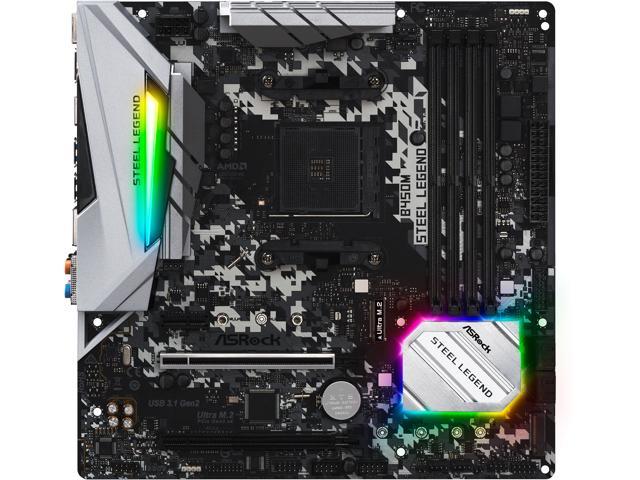
ASRock B450M Steel Legend AM4 Micro ATX Motherboard - Newegg.com
Buy ASRock B450M Steel Legend AM4 AMD Promontory B450 SATA 6Gb/s Micro ATX AMD Motherboard with fast shipping and top-rated customer service. Once you know, you Newegg!www.newegg.com
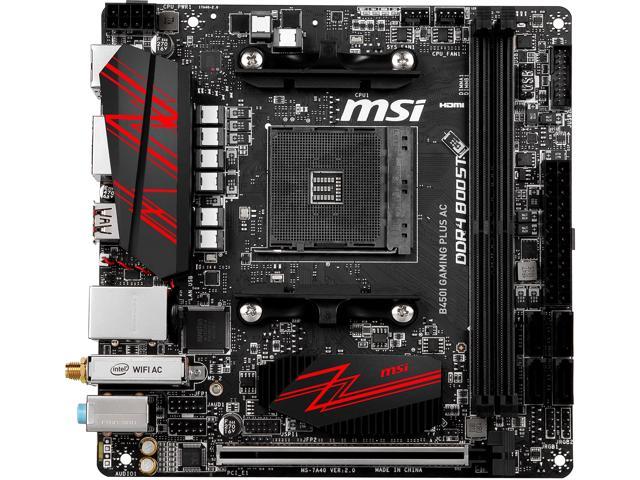
MSI Performance Gaming B450I Plus AC Mini ITX Motherboard - Newegg.com
Buy Used - Like New: MSI PERFORMANCE GAMING B450I GAMING PLUS AC AM4 AMD B450 SATA 6Gb/s Mini ITX AMD Motherboard with fast shipping and top-rated customer service. Once you know, you Newegg!www.newegg.com
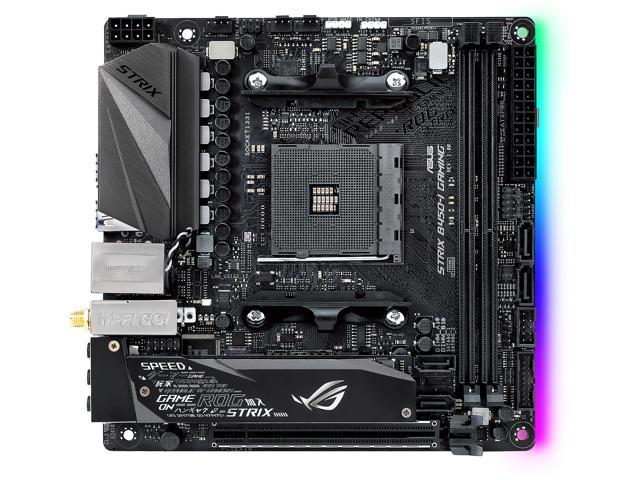
ASUS ROG STRIX B450-I GAMING AM4 Mini ITX AMD Motherboard - Newegg.com
Buy ASUS ROG STRIX B450-I GAMING AM4 AMD B450 SATA 6Gb/s USB 3.1 HDMI Mini ITX AMD Motherboard with fast shipping and top-rated customer service. Once you know, you Newegg!www.newegg.com
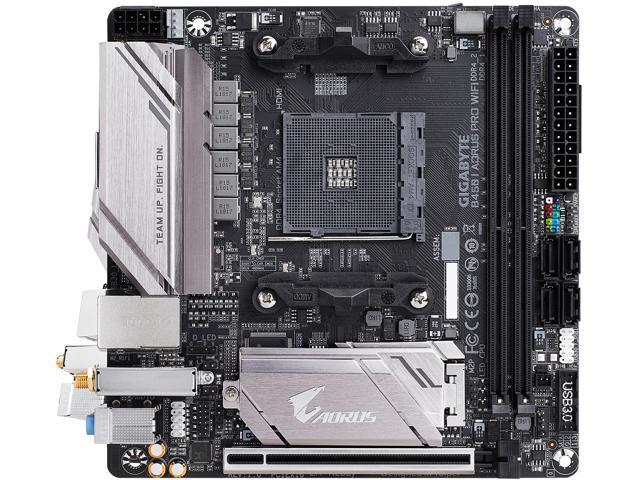
GIGABYTE B450 I AORUS PRO WIFI AM4 Mini ITX AMD Motherboard - Newegg.com
Buy GIGABYTE B450 I AORUS PRO WIFI AM4 AMD B450 SATA 6Gb/s USB 3.1 HDMI Mini ITX AMD Motherboard with fast shipping and top-rated customer service. Once you know, you Newegg!www.newegg.com
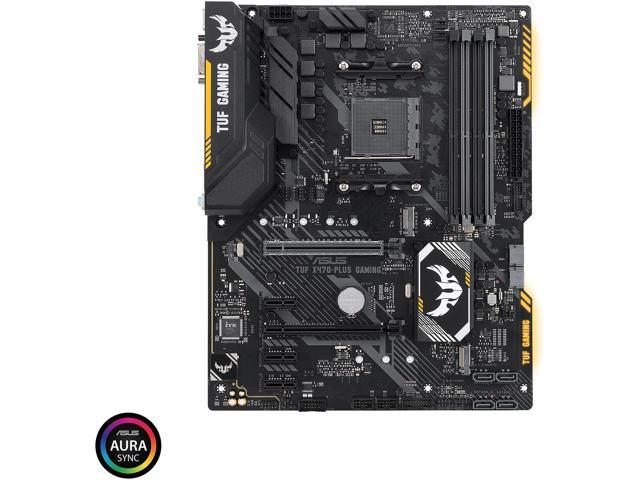
ASUS TUF X470-Plus Gaming AM4 ATX AMD Motherboard - Newegg.com
Buy ASUS TUF X470-Plus Gaming AM4 AMD X470 SATA 6Gb/s USB 3.1 HDMI ATX AMD Motherboard with fast shipping and top-rated customer service. Once you know, you Newegg!www.newegg.com
Every one of these will work well for the OP's needs.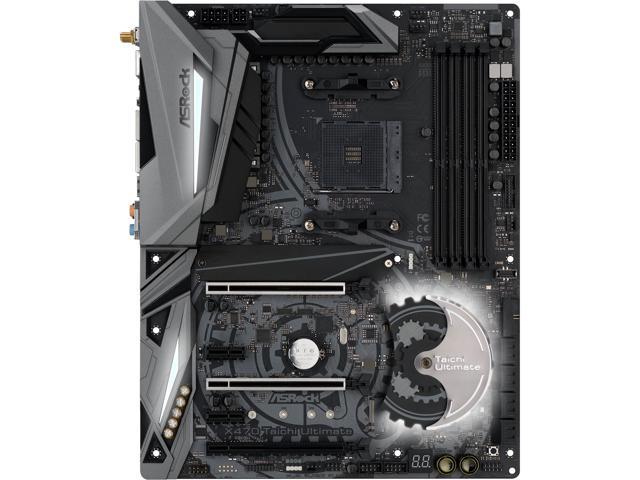
ASRock X470 Taichi Ultimate AM4 ATX AMD Motherboard - Newegg.com
Buy ASRock X470 Taichi Ultimate AM4 AMD Ryzen 3000 Series CPU Ready ATX AMD Motherboard with fast shipping and top-rated customer service. Once you know, you Newegg!www.newegg.com
not true. the gigabyte board is not good enough. i have it (see attachment). it does not feed the CPU enough power. the 3900X should score around 7100 in cinebench R20. on the gigabyte B450-i it gets between 6300 and 6800. always a random number. i thought my board was bad or the CPU was a dud. the CPU checks out fine in a low end lenovo desktop board with the same SSD* and RAM. the replacement gigabyte B450-i i got is equally worthless. does the same thing.
i also tried other benches and tried running an adobe premiere job. the gigabyte board comes up short every time. i started this thread specifically because the gigabyte B450-i that i have does not do what i need it to do.
those asrock boards are probably even worse. i've seen reviews of those boards, from both professionals and users, saying they gimp R7 CPUs. R9 need not apply. they both use the same worthless 3 phase VRM, with doublers, and terrible cooling.
back to the topic, thank you everyone for the input. there is some amazing in-depth information here. i learned more than i thought i would. i will go with the MSI board. i will only need 1 M.2 slot and don't care about the audio chipset. i will update this post to let you guys know how it handles the 3900X.
Last edited by a moderator:
- Joined
- Sep 16, 2018
- Messages
- 10,618 (4.34/day)
- Location
- Winnipeg, Canada
| Processor | AMD R9 9900X @ booost |
|---|---|
| Motherboard | Asus Strix X670E-F |
| Cooling | Thermalright Phantom Spirit 120 EVO, 2x T30 |
| Memory | 2x 16GB Lexar Ares @ 6400 28-36-36-68 1.55v |
| Video Card(s) | Zotac 4070 Ti Trinity OC @ 3045/1500 |
| Storage | WD SN850 1TB, SN850X 2TB, 2x SN770 1TB |
| Display(s) | LG 50UP7100 |
| Case | Asus ProArt PA602 |
| Audio Device(s) | JBL Bar 700 |
| Power Supply | Seasonic Vertex GX-1000, Monster HDP1800 |
| Mouse | Logitech G502 Hero |
| Keyboard | Logitech G213 |
| VR HMD | Oculus 3 |
| Software | Yes |
| Benchmark Scores | Yes |
Lots of good info here, very educational.
- Joined
- Sep 3, 2019
- Messages
- 4,003 (1.91/day)
- Location
- Thessaloniki, Greece
| System Name | PC on since March 2025, upgraded from 5900X |
|---|---|
| Processor | Ryzen 7 9700X (March 2025), 140W PPT limit, 85C temp limit, CO -25, +100MHz (up to 5.65GHz) |
| Motherboard | Asrock X870E NOVA, BIOS v3.2, AGESA PI 1.2.0.3a Patch A |
| Cooling | Arctic Liquid Freezer II 420mm Rev7 (Jan 2024) with off-center mount for Ryzen, TIM: Kryosheet |
| Memory | 2x32GB G.Skill Trident Z5 RGB (March2025) 6000MT/s 1.40V CL30-36-36-36-68-104 1T, tRFC:500, Hynix-A |
| Video Card(s) | Sapphire Nitro+ RX 7900XTX (Dec 2023) 314~467W (370W current) PowerLimit, 1070mV, Adrenalin v25.5.1 |
| Storage | NVMe: 990Pro 2TB(OS 25), 980Pro 1TB(22), 970Pro 512(19) / S-III: 850Pro 1TB(15) 860Evo 1TB(20) |
| Display(s) | Dell Alienware AW3423DW 34" QD-OLED curved (1800R), 3440x1440 144Hz (max 175Hz) HDR400/1000, VRR on |
| Case | Thermaltake Core P8 TG Gaming Full Tower, Fans: 9x140mm + 3x120mm |
| Audio Device(s) | Astro A50 headset |
| Power Supply | Corsair HX750i, ATX v2.4, 80+ Platinum, 93% (250~700W), modular, single/dual rail (switch) |
| Mouse | Logitech MX Master (Gen1) |
| Keyboard | Logitech G15 (Gen2) w/ LCDSirReal applet |
| Software | Windows 11 Home 64bit (v24H2, OSBuild 26100.4061), 1st install March 2025 |
3900X in some circumstances could reach 7300~7400 in R20.not true. the gigabyte board is not good enough. i have it (see attachment). it does not feed the CPU enough power. the 3900X should score around 7100 in cinebench R20. on the gigabyte B450-i it gets between 6300 and 6800. always a random number. i thought my board was bad or the CPU was a dud. the CPU checks out fine in low end lenovo desktop board with the same memory and RAM. the replacement gigabyte B450-i i got is equally worthless. does the same thing.
i also tried other benches and tried running an adobe premiere job. the gigabyte board comes up short every time. i started this thread specifically because the gigabyte B450-i that i have does not do what i need it to do.
those asrock boards are probably even worse. i've seen reviews of those boards, from both professionals and users, saying they gimp R7 CPUs. R9 need not apply. they both use the same worthless 3 phase VRM, with doublers, and terrible cooling.
back to the topic, thank you everyone for the input. there is some amazing in-depth information here. i learned more than i thought i would. i will go with the MSI board. i will only need 1 M.2 slot and don't care about the audio chipset. i will update this post to let you guys know how it handles the 3900X.
Out of curiosity... what Lenovo board was that? Did you test it in the same case as the B450I Aorus?
To take it further, can you screenshot a HWiNFO sensors page during R20 run?
Like this where all info available/visible...
I’m interested in this kind of info, but at the same time I like to see if I can find anything else that could be wrong, other than board’s VRM.
Although 4 phases of 50A each isn’t good enough for a 140A CPU... That’s not hard to think.
Last edited by a moderator:
- Joined
- Nov 2, 2013
- Messages
- 475 (0.11/day)
| System Name | Auriga |
|---|---|
| Processor | Ryzen 9950X3D w/ aquacomputer cuplex kryos NEXT with VISION - acrylic/nickel |
| Motherboard | Asus X870E-E + Intel X520-DA2 NIC |
| Cooling | Alphacool Res/D5 Combo •• Corsair XR7 480mm + Black Ice Nemesis 360GTS radiators •• 7xNF-A12 chromax |
| Memory | 96GB Corsair Dominator 6600MT/s CL32 running @ 6200MT/s CL28 (CMP96GX5M2B6600C32) |
| Video Card(s) | Gigabyte RTX 5090 Aorus Master, waiting for waterblock |
| Storage | 2TB inland TD510 Gen5 ••• 4TB WD Black SN850X ••• 80TB UNRAID NAS |
| Display(s) | Alienware AW3423DWF (3440x1440, 10-bit @ 145Hz) |
| Case | Thermaltake Core P8 |
| Power Supply | Corsair AX1600i |
| Mouse | Razer Viper V2 Pro (FPS games) + Logitech MX Master 2S (everything else) |
| Keyboard | Keycult No2 rev 1 w/Amber Alps and TX stabilizers on a steel plate. DCS 9009 WYSE keycaps |
| Software | W11 X64 Pro |
| Benchmark Scores | https://valid.x86.fr/c3rxw7 |
3900X in some circumstances could reach 7300~7400 in R20.
Out of curiosity... what Lenovo board was that? Did you test it in the same case as the B450I Aorus?
To take it further, can you screenshot a HWiNFO sensors page during R20 run?
Like this where all info available/visible...
I’m interested in this kind of info, but at the same time I like to see if I can find anything else that could be wrong, other than board’s VRM.
Although 4 phases of 50A each isn’t good enough for a 140A CPU... That’s not hard to think.
the B450-i was on a test bench. not in a case. but i used the same ssd and memory. the lenovo PC is a thinkcentre. can't remember the exact model. i'll get back to you on that. it originally came with a 2700X pro CPU. it's a regular, off the shelf office PC. nothing special.
i'll try to get that HWinfo and post it here.
- Joined
- Sep 3, 2019
- Messages
- 4,003 (1.91/day)
- Location
- Thessaloniki, Greece
| System Name | PC on since March 2025, upgraded from 5900X |
|---|---|
| Processor | Ryzen 7 9700X (March 2025), 140W PPT limit, 85C temp limit, CO -25, +100MHz (up to 5.65GHz) |
| Motherboard | Asrock X870E NOVA, BIOS v3.2, AGESA PI 1.2.0.3a Patch A |
| Cooling | Arctic Liquid Freezer II 420mm Rev7 (Jan 2024) with off-center mount for Ryzen, TIM: Kryosheet |
| Memory | 2x32GB G.Skill Trident Z5 RGB (March2025) 6000MT/s 1.40V CL30-36-36-36-68-104 1T, tRFC:500, Hynix-A |
| Video Card(s) | Sapphire Nitro+ RX 7900XTX (Dec 2023) 314~467W (370W current) PowerLimit, 1070mV, Adrenalin v25.5.1 |
| Storage | NVMe: 990Pro 2TB(OS 25), 980Pro 1TB(22), 970Pro 512(19) / S-III: 850Pro 1TB(15) 860Evo 1TB(20) |
| Display(s) | Dell Alienware AW3423DW 34" QD-OLED curved (1800R), 3440x1440 144Hz (max 175Hz) HDR400/1000, VRR on |
| Case | Thermaltake Core P8 TG Gaming Full Tower, Fans: 9x140mm + 3x120mm |
| Audio Device(s) | Astro A50 headset |
| Power Supply | Corsair HX750i, ATX v2.4, 80+ Platinum, 93% (250~700W), modular, single/dual rail (switch) |
| Mouse | Logitech MX Master (Gen1) |
| Keyboard | Logitech G15 (Gen2) w/ LCDSirReal applet |
| Software | Windows 11 Home 64bit (v24H2, OSBuild 26100.4061), 1st install March 2025 |
For the Lenovo board it’s not all that significant. The most I wanted to know was the test conditions and if it was the same, but as it turns out the B450-I test bench is better for thermals.the B450-i was on a test bench. not in a case. but i used the same ssd and memory. the lenovo PC is a thinkcentre. can't remember the exact model. i'll get back to you on that. it originally came with a 2700X pro CPU. it's a regular, off the shelf office PC. nothing special.
i'll try to get that HWinfo and post it here.
- Joined
- Nov 6, 2019
- Messages
- 326 (0.16/day)
- Location
- Nuremberg
| Processor | Core i7 8700K@5 GHz |
|---|---|
| Motherboard | MSI Z370 Gaming Pro Carbon |
| Cooling | 2xEKWB Rads, EKWB Reservoir 250, Aqua Computer Kryos Next CPU Cooler, Phanteks Glacier GPU Cooler |
| Memory | 16 GB DDR4 GSkill Trident Z 3200 |
| Video Card(s) | Asus ROG STRIX RTX 2080 O8G (GPU@2115 MHz/VRAM@7800MHz) |
| Storage | 1x Samsung Evo 840 SSD 256, 1x WD Blue 1 TB HDD |
| Display(s) | Asus ROG Swift PG248 1080p Display/144Hz/G-Sync |
| Case | Fractal Design R6 with Window |
| Audio Device(s) | Realtek onboard |
| Power Supply | be quiet 650W Straight Power |
| Mouse | Logitech G502 |
| Keyboard | Cherry KB |
| Software | Win 10 Pro |
| Benchmark Scores | FireStrike: 25953/Extreme: 13141/Ultra: 7099/TimeSpy: 11426/Superposition: 7667/CinebenchR20: 3916 |
those asrock boards are probably even worse. i've seen reviews of those boards, from both professionals and users, saying they gimp R7 CPUs. R9 need not apply. they both use the same worthless 3 phase VRM, with doublers, and terrible cooling.
The Asrock VRM is crap...it has Onsemi discrete MOSFETS whereas MSI or Gigabyte use integrated power stages here. The efficiency and heat dissipation of those discrete MOSFETS is not as good as those of power stages. And as it has only 3 real phases, they do a twin arrangement of 3x2 phases to reduce load and heat on each phase. But also MSI use discrete MOSFETS on their X570 Gaming Plus or Gaming Edge Boards...not the best solution but cheap...
The next problem is output ripple which degenerates cpu over time and which is worse with 3 real phases compared to 6 real phases.
Last edited:
- Joined
- Jul 5, 2013
- Messages
- 31,052 (7.14/day)
This is absolute nonsense. Voltage ripple does not degrade CPU's unless excessive voltage is being applied, but then you have a much bigger problem.The next problem is output ripple which degenerates cpu over time and which is worse with 3 real phases compared to 6 real phases.
- Joined
- Nov 6, 2019
- Messages
- 326 (0.16/day)
- Location
- Nuremberg
| Processor | Core i7 8700K@5 GHz |
|---|---|
| Motherboard | MSI Z370 Gaming Pro Carbon |
| Cooling | 2xEKWB Rads, EKWB Reservoir 250, Aqua Computer Kryos Next CPU Cooler, Phanteks Glacier GPU Cooler |
| Memory | 16 GB DDR4 GSkill Trident Z 3200 |
| Video Card(s) | Asus ROG STRIX RTX 2080 O8G (GPU@2115 MHz/VRAM@7800MHz) |
| Storage | 1x Samsung Evo 840 SSD 256, 1x WD Blue 1 TB HDD |
| Display(s) | Asus ROG Swift PG248 1080p Display/144Hz/G-Sync |
| Case | Fractal Design R6 with Window |
| Audio Device(s) | Realtek onboard |
| Power Supply | be quiet 650W Straight Power |
| Mouse | Logitech G502 |
| Keyboard | Cherry KB |
| Software | Win 10 Pro |
| Benchmark Scores | FireStrike: 25953/Extreme: 13141/Ultra: 7099/TimeSpy: 11426/Superposition: 7667/CinebenchR20: 3916 |
Sure, if you have 25mV ripple and you need for a stable oc 1.375V then you have to set 1.4V to get stable. So the Chip degrades at 1.4V but you only would need 1.375V.
- Joined
- Jul 5, 2013
- Messages
- 31,052 (7.14/day)
Most voltage ripple is measured in .005v increments..Sure, if you have 25mV ripple
That depends on the voltage specs for the CPU's in question. 1.4v is not going to damage an AM4 CPU long term.So the Chip degrades at 1.4V but you only would need 1.375V.
- Joined
- Nov 6, 2019
- Messages
- 326 (0.16/day)
- Location
- Nuremberg
| Processor | Core i7 8700K@5 GHz |
|---|---|
| Motherboard | MSI Z370 Gaming Pro Carbon |
| Cooling | 2xEKWB Rads, EKWB Reservoir 250, Aqua Computer Kryos Next CPU Cooler, Phanteks Glacier GPU Cooler |
| Memory | 16 GB DDR4 GSkill Trident Z 3200 |
| Video Card(s) | Asus ROG STRIX RTX 2080 O8G (GPU@2115 MHz/VRAM@7800MHz) |
| Storage | 1x Samsung Evo 840 SSD 256, 1x WD Blue 1 TB HDD |
| Display(s) | Asus ROG Swift PG248 1080p Display/144Hz/G-Sync |
| Case | Fractal Design R6 with Window |
| Audio Device(s) | Realtek onboard |
| Power Supply | be quiet 650W Straight Power |
| Mouse | Logitech G502 |
| Keyboard | Cherry KB |
| Software | Win 10 Pro |
| Benchmark Scores | FireStrike: 25953/Extreme: 13141/Ultra: 7099/TimeSpy: 11426/Superposition: 7667/CinebenchR20: 3916 |
That was only an example, with higher voltage the effect is still there.
- Joined
- Jul 5, 2013
- Messages
- 31,052 (7.14/day)
Whether or not voltage ripple is present is not what I'm taking issue with. Voltage ripple ALWAYS exists because everyone in the world runs on AC power grids. What defines how great the effect is depends on the PSU and mobo quality. A solid PSU will make even a low quality board run well, where as a crap PSU will make even the best board run like crap.That was only an example, with higher voltage the effect is still there.
The OP is not going to match a solid board to a crap PSU, so voltage ripple will not be an issue. And for the record, 3x2 phase power is electronically as a stable a 6x1. The VRM part quality is more important than that of the end configuration.
Last edited:
- Joined
- Nov 6, 2019
- Messages
- 326 (0.16/day)
- Location
- Nuremberg
| Processor | Core i7 8700K@5 GHz |
|---|---|
| Motherboard | MSI Z370 Gaming Pro Carbon |
| Cooling | 2xEKWB Rads, EKWB Reservoir 250, Aqua Computer Kryos Next CPU Cooler, Phanteks Glacier GPU Cooler |
| Memory | 16 GB DDR4 GSkill Trident Z 3200 |
| Video Card(s) | Asus ROG STRIX RTX 2080 O8G (GPU@2115 MHz/VRAM@7800MHz) |
| Storage | 1x Samsung Evo 840 SSD 256, 1x WD Blue 1 TB HDD |
| Display(s) | Asus ROG Swift PG248 1080p Display/144Hz/G-Sync |
| Case | Fractal Design R6 with Window |
| Audio Device(s) | Realtek onboard |
| Power Supply | be quiet 650W Straight Power |
| Mouse | Logitech G502 |
| Keyboard | Cherry KB |
| Software | Win 10 Pro |
| Benchmark Scores | FireStrike: 25953/Extreme: 13141/Ultra: 7099/TimeSpy: 11426/Superposition: 7667/CinebenchR20: 3916 |
The more phases you have the less the ripple effect, also the higher your pwm controller is switching the less the ripple effect or you have crap or good inductors may also be a point here. Why do oc mainboards have the Feature to adjust PWM switching frequency? One point is to reduce ripple.
A real 6 phase vrm is way better than a 3x2 or 3 phases doubled vrm.
Edit:
It depends not on the PSU and a solid PSU doesn‘t compensate a crap vrm in any way.
A real 6 phase vrm is way better than a 3x2 or 3 phases doubled vrm.
Edit:
It depends not on the PSU and a solid PSU doesn‘t compensate a crap vrm in any way.
Last edited:
- Joined
- Feb 20, 2019
- Messages
- 9,428 (4.12/day)
| System Name | Bragging Rights |
|---|---|
| Processor | Atom Z3735F 1.33GHz |
| Motherboard | It has no markings but it's green |
| Cooling | No, it's a 2.2W processor |
| Memory | 2GB DDR3L-1333 |
| Video Card(s) | Gen7 Intel HD (4EU @ 311MHz) |
| Storage | 32GB eMMC and 128GB Sandisk Extreme U3 |
| Display(s) | 10" IPS 1280x800 60Hz |
| Case | Veddha T2 |
| Audio Device(s) | Apparently, yes |
| Power Supply | Samsung 18W 5V fast-charger |
| Mouse | MX Anywhere 2 |
| Keyboard | Logitech MX Keys (not Cherry MX at all) |
| VR HMD | Samsung Oddyssey, not that I'd plug it into this though.... |
| Software | W10 21H1, barely |
| Benchmark Scores | I once clocked a Celeron-300A to 564MHz on an Abit BE6 and it scored over 9000. |
I can confirm that PBO+ works fine with a 3900X using both an MSI B450M Mortar Max (2+2 phase) and Asrock B450 Pro (3x2 phase). Ryzen Master shows power draw of between 135 and 140W with my two samples.
These are both relatively low end boards for a 3900X but with half-decent VRM and proper heatsinks they don't seem to have any issues with PBO+
I'm not sure I'd be going for overclocking records with them but IMO there's really no point pumping huge amounts of juice into Zen2. It's 98% of the way there using stock voltages on PBO+ and whilst you can definitely push it higher than that, throwing silly amounts of voltage at them will get you a hundred MHz maybe, but an earful of fan noise and potentially short lifespan of the chip.
These are both relatively low end boards for a 3900X but with half-decent VRM and proper heatsinks they don't seem to have any issues with PBO+
I'm not sure I'd be going for overclocking records with them but IMO there's really no point pumping huge amounts of juice into Zen2. It's 98% of the way there using stock voltages on PBO+ and whilst you can definitely push it higher than that, throwing silly amounts of voltage at them will get you a hundred MHz maybe, but an earful of fan noise and potentially short lifespan of the chip.
- Joined
- Nov 2, 2013
- Messages
- 475 (0.11/day)
| System Name | Auriga |
|---|---|
| Processor | Ryzen 9950X3D w/ aquacomputer cuplex kryos NEXT with VISION - acrylic/nickel |
| Motherboard | Asus X870E-E + Intel X520-DA2 NIC |
| Cooling | Alphacool Res/D5 Combo •• Corsair XR7 480mm + Black Ice Nemesis 360GTS radiators •• 7xNF-A12 chromax |
| Memory | 96GB Corsair Dominator 6600MT/s CL32 running @ 6200MT/s CL28 (CMP96GX5M2B6600C32) |
| Video Card(s) | Gigabyte RTX 5090 Aorus Master, waiting for waterblock |
| Storage | 2TB inland TD510 Gen5 ••• 4TB WD Black SN850X ••• 80TB UNRAID NAS |
| Display(s) | Alienware AW3423DWF (3440x1440, 10-bit @ 145Hz) |
| Case | Thermaltake Core P8 |
| Power Supply | Corsair AX1600i |
| Mouse | Razer Viper V2 Pro (FPS games) + Logitech MX Master 2S (everything else) |
| Keyboard | Keycult No2 rev 1 w/Amber Alps and TX stabilizers on a steel plate. DCS 9009 WYSE keycaps |
| Software | W11 X64 Pro |
| Benchmark Scores | https://valid.x86.fr/c3rxw7 |
Try running cinebench r20 Back to back a few times, let me know what score you get and if it’s consistent or not.I can confirm that PBO+ works fine with a 3900X using both an MSI B450M Mortar Max (2+2 phase) and Asrock B450 Pro (3x2 phase). Ryzen Master shows power draw of between 135 and 140W with my two samples.
These are both relatively low end boards for a 3900X but with half-decent VRM and proper heatsinks they don't seem to have any issues with PBO+
I'm not sure I'd be going for overclocking records with them but IMO there's really no point pumping huge amounts of juice into Zen2. It's 98% of the way there using stock voltages on PBO+ and whilst you can definitely push it higher than that, throwing silly amounts of voltage at them will get you a hundred MHz maybe, but an earful of fan noise and potentially short lifespan of the chip.
- Joined
- Jul 5, 2013
- Messages
- 31,052 (7.14/day)
You're sticking these parts into an ITX case, are you really going to be stressing it that much?Try running cinebench r20 Back to back a few times, let me know what score you get and if it’s consistent or not.
- Joined
- Nov 6, 2019
- Messages
- 326 (0.16/day)
- Location
- Nuremberg
| Processor | Core i7 8700K@5 GHz |
|---|---|
| Motherboard | MSI Z370 Gaming Pro Carbon |
| Cooling | 2xEKWB Rads, EKWB Reservoir 250, Aqua Computer Kryos Next CPU Cooler, Phanteks Glacier GPU Cooler |
| Memory | 16 GB DDR4 GSkill Trident Z 3200 |
| Video Card(s) | Asus ROG STRIX RTX 2080 O8G (GPU@2115 MHz/VRAM@7800MHz) |
| Storage | 1x Samsung Evo 840 SSD 256, 1x WD Blue 1 TB HDD |
| Display(s) | Asus ROG Swift PG248 1080p Display/144Hz/G-Sync |
| Case | Fractal Design R6 with Window |
| Audio Device(s) | Realtek onboard |
| Power Supply | be quiet 650W Straight Power |
| Mouse | Logitech G502 |
| Keyboard | Cherry KB |
| Software | Win 10 Pro |
| Benchmark Scores | FireStrike: 25953/Extreme: 13141/Ultra: 7099/TimeSpy: 11426/Superposition: 7667/CinebenchR20: 3916 |
If one of these boards then take the Mortar, stay away from the Asrock. The Mortar has 4 phases and 2 Low/High Side MOSFETs per phase, each capable of 80A max. They have also less resistance.
The Asrock only 3 phases, twin arrangement, with 2 Low/High Side MOSFETs per phase, each capable of 65A max and higher resistance, so MSI should stay cooler here.
The Asrock only 3 phases, twin arrangement, with 2 Low/High Side MOSFETs per phase, each capable of 65A max and higher resistance, so MSI should stay cooler here.
Last edited:
- Joined
- Sep 16, 2018
- Messages
- 10,618 (4.34/day)
- Location
- Winnipeg, Canada
| Processor | AMD R9 9900X @ booost |
|---|---|
| Motherboard | Asus Strix X670E-F |
| Cooling | Thermalright Phantom Spirit 120 EVO, 2x T30 |
| Memory | 2x 16GB Lexar Ares @ 6400 28-36-36-68 1.55v |
| Video Card(s) | Zotac 4070 Ti Trinity OC @ 3045/1500 |
| Storage | WD SN850 1TB, SN850X 2TB, 2x SN770 1TB |
| Display(s) | LG 50UP7100 |
| Case | Asus ProArt PA602 |
| Audio Device(s) | JBL Bar 700 |
| Power Supply | Seasonic Vertex GX-1000, Monster HDP1800 |
| Mouse | Logitech G502 Hero |
| Keyboard | Logitech G213 |
| VR HMD | Oculus 3 |
| Software | Yes |
| Benchmark Scores | Yes |
Crank up voltage and LLC, move some air over VRMs and let er rip. . It only gets warm if you let it  Guys are saying it runs, kick it in the nuts it'll do something for awhile. If you want to want to run your overclocks 24/7 you should be buying a good board anyways to run those overclocks.
Guys are saying it runs, kick it in the nuts it'll do something for awhile. If you want to want to run your overclocks 24/7 you should be buying a good board anyways to run those overclocks.
 Guys are saying it runs, kick it in the nuts it'll do something for awhile. If you want to want to run your overclocks 24/7 you should be buying a good board anyways to run those overclocks.
Guys are saying it runs, kick it in the nuts it'll do something for awhile. If you want to want to run your overclocks 24/7 you should be buying a good board anyways to run those overclocks.- Joined
- Nov 2, 2013
- Messages
- 475 (0.11/day)
| System Name | Auriga |
|---|---|
| Processor | Ryzen 9950X3D w/ aquacomputer cuplex kryos NEXT with VISION - acrylic/nickel |
| Motherboard | Asus X870E-E + Intel X520-DA2 NIC |
| Cooling | Alphacool Res/D5 Combo •• Corsair XR7 480mm + Black Ice Nemesis 360GTS radiators •• 7xNF-A12 chromax |
| Memory | 96GB Corsair Dominator 6600MT/s CL32 running @ 6200MT/s CL28 (CMP96GX5M2B6600C32) |
| Video Card(s) | Gigabyte RTX 5090 Aorus Master, waiting for waterblock |
| Storage | 2TB inland TD510 Gen5 ••• 4TB WD Black SN850X ••• 80TB UNRAID NAS |
| Display(s) | Alienware AW3423DWF (3440x1440, 10-bit @ 145Hz) |
| Case | Thermaltake Core P8 |
| Power Supply | Corsair AX1600i |
| Mouse | Razer Viper V2 Pro (FPS games) + Logitech MX Master 2S (everything else) |
| Keyboard | Keycult No2 rev 1 w/Amber Alps and TX stabilizers on a steel plate. DCS 9009 WYSE keycaps |
| Software | W11 X64 Pro |
| Benchmark Scores | https://valid.x86.fr/c3rxw7 |
You're sticking these parts into an ITX case, are you really going to be stressing it that much?
if the motherboard buckles under stress from a 10 second benchmark, then it will not last long. this is a complicated build and if i have to take it apart one more time i might just flip out.
- Joined
- Jul 5, 2013
- Messages
- 31,052 (7.14/day)
Your opinions are high subjective. The MSI has a much older audio chipset.If one of these boards then take the Mortar, stay away from the Asrock. The Mortar has 4 phases and 2 Low/High Side MOSFETs per phase, each capable of 80A max. They have also less resistance.
The Asrock only 3 phases, twin arrangement, with 2 Low/High Side MOSFETs per phase, each capable of 65A max and higher resistance, so MSI should stay cooler here.
Fair enough.if the motherboard buckles under stress from a 10 second benchmark, then it will not last long. this is a complicated build and if i have to take it apart one more time i might just flip out.
Last edited:
- Joined
- Mar 22, 2019
- Messages
- 461 (0.20/day)
- Location
- Western NY, USA
| Processor | AMD Ryzen 7 3700x |
|---|---|
| Motherboard | Asus ROG Strix X470-F Gaming |
| Cooling | Scythe Ninja 5 |
| Memory | G.Skill Ripjaws V 16GB (2 x 8GB) (F4-3600C16D-16GVKC) @ 3733 MHz 16-19-19-19-36-56 |
| Video Card(s) | MSI RTX 2060 Super Armor OC 8GB |
| Storage | 1x Samsung 970 EVO 500GB / 3x Crucial MX500 / 4 HDDs |
| Display(s) | Dell 23" LCD S2316M |
| Case | Rosewill Rise Glow |
| Power Supply | CORSAIR RM650 |
| Mouse | Cooler Master MS120 |
| Keyboard | Cooler Master MS120 |
| Software | Windows 10 Pro x64 |
I have an AsusROG Strix B450-F (4 phase) and an Asus ROG Strix X470-F (6 phase) and they both worked very well with my 3700x.
And from the info I found here:

 docs.google.com
docs.google.com
The B450-I and X450-I and both a step above the B450-F and a slight step down from my X470-F as far as VMs go so either should run the 3900x just fine with PBO set on auto and decent case airflow.
And from the info I found here:
AM4 B450/X470 Motherboard Vcore VRM Tier List v1.3
The B450-I and X450-I and both a step above the B450-F and a slight step down from my X470-F as far as VMs go so either should run the 3900x just fine with PBO set on auto and decent case airflow.
- Joined
- Nov 6, 2019
- Messages
- 326 (0.16/day)
- Location
- Nuremberg
| Processor | Core i7 8700K@5 GHz |
|---|---|
| Motherboard | MSI Z370 Gaming Pro Carbon |
| Cooling | 2xEKWB Rads, EKWB Reservoir 250, Aqua Computer Kryos Next CPU Cooler, Phanteks Glacier GPU Cooler |
| Memory | 16 GB DDR4 GSkill Trident Z 3200 |
| Video Card(s) | Asus ROG STRIX RTX 2080 O8G (GPU@2115 MHz/VRAM@7800MHz) |
| Storage | 1x Samsung Evo 840 SSD 256, 1x WD Blue 1 TB HDD |
| Display(s) | Asus ROG Swift PG248 1080p Display/144Hz/G-Sync |
| Case | Fractal Design R6 with Window |
| Audio Device(s) | Realtek onboard |
| Power Supply | be quiet 650W Straight Power |
| Mouse | Logitech G502 |
| Keyboard | Cherry KB |
| Software | Win 10 Pro |
| Benchmark Scores | FireStrike: 25953/Extreme: 13141/Ultra: 7099/TimeSpy: 11426/Superposition: 7667/CinebenchR20: 3916 |
Your opinions are high subjective. The MSI has a much old audio chipset.
Ok, that could be true, didn't look for other components of those mainbaords as OP asks a vrm question.
The B450-I and X450-I and both a step above the B450-F and a slight step down from my X470-F as far as VMs go so either should run the 3900x just fine with PBO set on auto and decent case airflow.
The Asus X470 and the MSI B450I should be vrm wise nearly the same, the Asus has a slightly better SOC vrm as far as I can see. As he looks for an ITX board I woulod recommend the MSI.
- Joined
- Feb 22, 2019
- Messages
- 757 (0.33/day)
Based on what proof, exactly?VRM wise the MSI B450I Gaming is the best.



